Opportunities Abound for Scan & Go Technology in US Retail
Today’s pandemic environment has retailers stepping up to implement solutions that make shopping safer, faster, and as touchless as possible. While some tactics may only be relevant in the short-term, the increased adoption of tech-driven solutions that broadly remove friction from the shopping process will likely reshape retail for years to come. We’ve discussed the disruptive impact of ecommerce-driven developments elsewhere, commenting on the importance of retailer agility in ecommerce fulfillment operations to address the needs of the new normal. In tandem with ecommerce acceleration, we are seeing retailers and solution providers increasingly turn their attention toward streamlining the in-store experience, which still accounts for more than $8.50 in $10.00 of all grocery dollars.
Retailers Focus on Re-imagining the In-store Shopping Experience
One of today’s most important examples of innovation for in-store shopping is in Scan & Go technologies. Scan & Go refers to tech-enabled solutions that let customers bypass the register by tracking items in real-time, enabling an unassisted checkout process. A prominent example of Scan & Go is Amazon’s Go stores, which debuted in 2018 and use cameras, sensors, and deep learning to create a checkout-free experience. Others have quickly followed suit, including Walmart, Sam’s Club, and Meijer—these large retailers have brought mobile device-based Scan & Go to their stores to varying degrees. And during the pandemic, the consumer has increasingly accepted these new technologies. Sam’s Club reported increased consumer usage of its Scan & Go program by fourfold, and recent research suggests about 7 in 10 consumers are now interested in shopping with Scan & Go. Young consumers are even likelier to express interest in utilizing Scan & Go, underscoring untapped potential of rolling out this technology to meet the preferences of the future consumer.
Passive and Active Scan & Go Models Offer Unique Challenges and Opportunities
In an Active Scan & Go model, the customer scans each item they take from shelves to their shopping cart. This can be achieved through smart shopping carts (equipped with have a screen, scanners, weight sensors, and cameras) for customers to use in a process similar to self-checkout.

Amazon’s smart Dash Cart used in Amazon Fresh stores Photo Credit: Business Insider
More commonly, active Scan & Go solutions allow customers to scan items using a mobile device. Mobile device-based Scan & Go technology is available through standalone startups as well as through broad suite vendors. To check out, customers typically go through a security chokepoint where they scan an identifier QR code to indicate they completed shopping. At that point, consumers may undergo additional security checks before selecting a mobile payment method from the store’s app.

Sam’s Club Scan and Go process. Image Source: Facebook
Passive Scan & Go, best known through Amazon Go stores, requires no item-level scanning from customers. Instead, passive solutions use dozens of cameras and advanced computer vision AI to track shoppers and the items in their cart. This model usually employs weight-sensors on store shelves to augment visual item tracking. Barring any irregularities flagged by security algorithms, shoppers simply walk out with their items and are subsequently charged through mobile pay on the store’s app.

Arrays of cameras and networked appliances in use at Amazon Go Photo Credit: TechCrunch
When executed correctly, Passive Scan & Go is a more seamless and elegant solution. However, some hurdles exist before widespread adoption becomes feasible. Passive Scan & Go is complex technology which has only been proven out in small-format stores and is vulnerable to significant technical speed bumps related to privacy, crowd tracking, and misattribution. Passive Scan & Go also requires heavy investments in the technology and a retrofit of the store. Despite these drawbacks, Passive Scan & Go is growing in popularity especially at airport and stadium stores, C-stores, and neighborhood markets. Passive Scan & Go vendors compete directly with Amazon, as the retail behemoth has begun licensing its “Just Walk Out” technology to outside parties.
The Future for Scan & Go is Bright
The appeal of Scan & Go is very evident for retailers, especially now. Customer-driven check-out reduces labor requirements and potentially reduces overall headcount. Reducing checkout time also increases customer throughput and satisfaction and reduces in-store crowding. The data collected from Scan & Go is also very useful: shopper path tracking can help retailers improve their planograms, signage, and targeted promotions as customers navigate the store, and product tracking can improve inventory visibility. Providers are improving anti-theft capabilities, a big hurdle for expansion to higher price-point categories. Some providers are pioneering new security innovations, for example, upstart Mishipay offers mobile-based Scan & Go with a patent-pending RFID tag system, making it a more secure option for apparel and consumer tech retailers. However, all these benefits hinge on shoppers actually using the technology. In an increasingly tech-driven and on-the-go world, the retailers and solution providers who make the shopping experience seamless, efficient, and enjoyable will win the day.
With growing experience and technology improvements, Scan & Go is poised to enter new retailers and new categories, changing the way consumers shop long after the pandemic. At baseline, Scan & Go of any variety should reduce or eliminate checkout time and create a contactless checkout experience. However, best-in-class Scan & Go will simplify and personalize each user’s experience with innovations like personalized product recommendations, recipes, shopping lists, promotions, and seamless integration to E-commerce shopping. Offering clear benefits for both retailers and customers, Scan & Go adoption may represent a rare win-win in today’s challenging retail environment.
Identify the Scan & Go Solution that is Right for Your Business
Scan & Go is a promising technology whose consumer and retailer adoption has been accelerated by the pandemic. There are myriad benefits Scan & Go technology affords retailers, and there has never been a better time to implement these solutions in stores. For advice or whether a Scan & Go solution may be right for your needs, simply contact us. We are happy to help you assess the right solution to positively impact your business.
No Comments